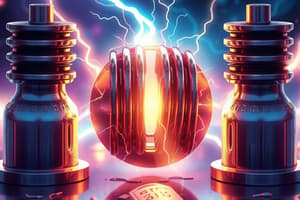Podcast
Questions and Answers
Match the following elements with their electrical conductivity characteristics:
Match the following elements with their electrical conductivity characteristics:
Copper (Cu) = Excellent electrical conductor Sulfur (S) = Poor conductor of electricity Sodium (Na) = Moderate electrical conductivity Carbon (C) = Varies in electrical conductivity based on its form
Match the following elements with their atomic bonding characteristics:
Match the following elements with their atomic bonding characteristics:
Copper (Cu) = Metallic bonding and delocalized valence electrons Sulfur (S) = Covalent bonding and shared electrons between atoms Sodium (Na) = Single valence electron in its outer shell Carbon (C) = Varies in bonding characteristics based on its form
Match the following elements with their structural forms:
Match the following elements with their structural forms:
Copper (Cu) = Metal lattice with delocalized valence electrons Sulfur (S) = Exists as S8 molecules with covalent bonds Sodium (Na) = Belongs to the alkali metal group Carbon (C) = Exists in various forms including diamond, graphite, and amorphous carbon
Match the following elements with their usage in practical applications:
Match the following elements with their usage in practical applications:
Match the electrical property or concept with its description:
Match the electrical property or concept with its description:
Match the electrical term with its definition:
Match the electrical term with its definition:
Match the electrical concept with its effect or consequence:
Match the electrical concept with its effect or consequence:
Match the following electrical concepts with their definitions:
Match the following electrical concepts with their definitions:
Match the following formulas with their respective electrical concepts:
Match the following formulas with their respective electrical concepts:
Match the following examples with their respective electrical calculations:
Match the following examples with their respective electrical calculations:
Match the following electrical concepts with their real-life applications:
Match the following electrical concepts with their real-life applications:
Flashcards are hidden until you start studying
Study Notes
Electrical Properties and Concepts Summary
- Sodium easily forms positive ions (Na+) due to the ease of removing its loosely held electron, allowing it to conduct electricity.
- Diamond is a non-metal and a poor conductor of electricity due to its covalent network solid structure with localized electrons.
- Aluminum is a metal with good electrical conductivity due to its metallic bonds and mobility of electrons, commonly used in electrical transmission lines.
- Silicon is a semiconductor with a covalent network structure, used in electronic devices like transistors and integrated circuits.
- Electric current is the flow of electric charge through a conductor, measured in amperes (A), with one ampere equivalent to one coulomb of charge passing per second.
- Electric voltage is the measure of electric potential difference in volts (V), driving the movement of electric charges through a circuit.
- Electric resistance, measured in ohms (Ω), is the opposition offered by a material or component to the flow of electric current.
- Understanding electric current, voltage, and resistance is crucial as they form the basis of understanding electrical circuits and their behavior.
- Electromotive force (EMF) provides energy per unit charge by a source like a battery, enabling devices to function.
- Potential difference is the difference in electric potential between two points in a circuit, causing current to flow through a resistor and generate heat and light.
- Ohm's Law (V = IR) relates voltage, current, and resistance, enabling the calculation of current flowing through a circuit.
- Thicker wires have less resistance than thinner wires, impacting the flow of electric current in a circuit.
Studying That Suits You
Use AI to generate personalized quizzes and flashcards to suit your learning preferences.




